FIAT PANDA 2018 Owner handbook (in English)
Manufacturer: FIAT, Model Year: 2018, Model line: PANDA, Model: FIAT PANDA 2018Pages: 228, PDF Size: 17.05 MB
Page 141 of 228
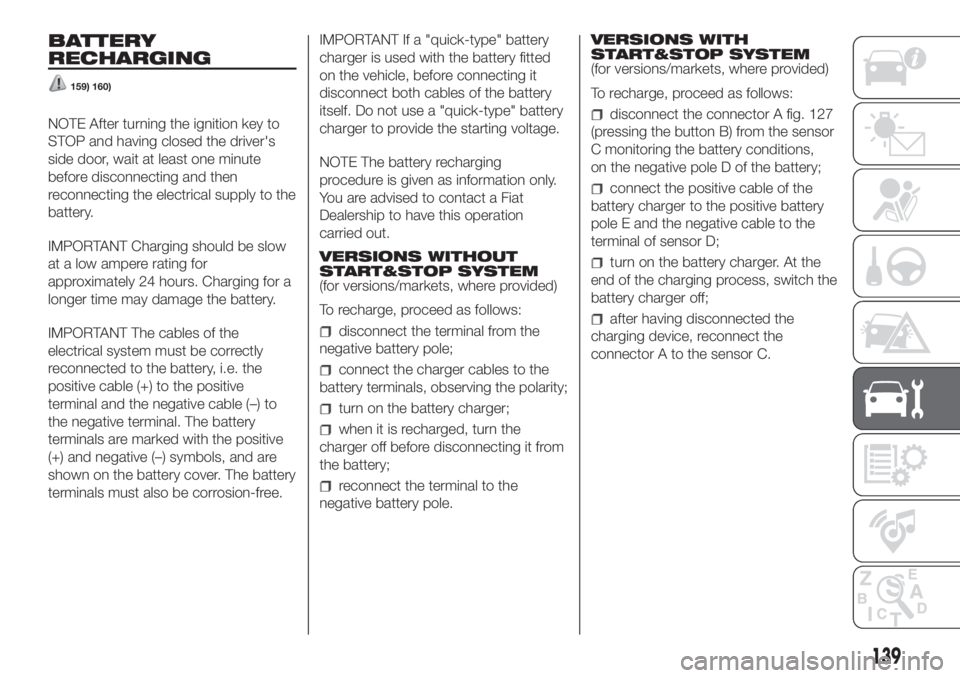
BATTERY
RECHARGING
159) 160)
NOTE After turning the ignition key to
STOP and having closed the driver's
side door, wait at least one minute
before disconnecting and then
reconnecting the electrical supply to the
battery.
IMPORTANT Charging should be slow
at a low ampere rating for
approximately 24 hours. Charging for a
longer time may damage the battery.
IMPORTANT The cables of the
electrical system must be correctly
reconnected to the battery, i.e. the
positive cable (+) to the positive
terminal and the negative cable (–) to
the negative terminal. The battery
terminals are marked with the positive
(+) and negative (–) symbols, and are
shown on the battery cover. The battery
terminals must also be corrosion-free.IMPORTANT If a "quick-type" battery
charger is used with the battery fitted
on the vehicle, before connecting it
disconnect both cables of the battery
itself. Do not use a "quick-type" battery
charger to provide the starting voltage.
NOTE The battery recharging
procedure is given as information only.
You are advised to contact a Fiat
Dealership to have this operation
carried out.
VERSIONS WITHOUT
START&STOP SYSTEM
(for versions/markets, where provided)
To recharge, proceed as follows:
disconnect the terminal from the
negative battery pole;
connect the charger cables to the
battery terminals, observing the polarity;
turn on the battery charger;
when it is recharged, turn the
charger off before disconnecting it from
the battery;
reconnect the terminal to the
negative battery pole.VERSIONS WITH
START&STOP SYSTEM
(for versions/markets, where provided)
To recharge, proceed as follows:
disconnect the connector A fig. 127
(pressing the button B) from the sensor
C monitoring the battery conditions,
on the negative pole D of the battery;
connect the positive cable of the
battery charger to the positive battery
pole E and the negative cable to the
terminal of sensor D;
turn on the battery charger. At the
end of the charging process, switch the
battery charger off;
after having disconnected the
charging device, reconnect the
connector A to the sensor C.
139
Page 142 of 228
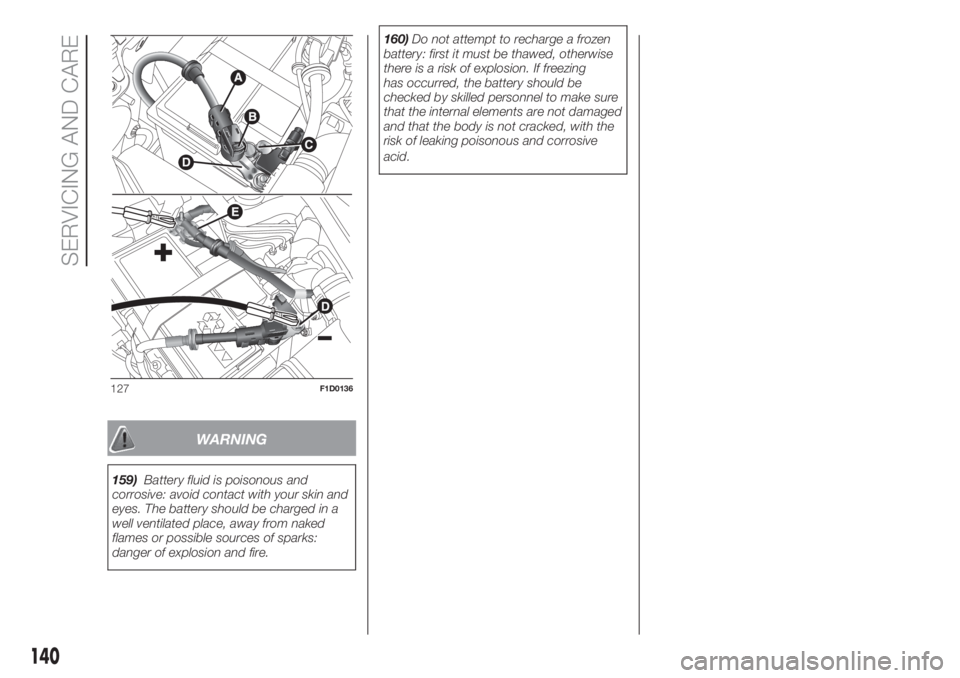
WARNING
159)Battery fluid is poisonous and
corrosive: avoid contact with your skin and
eyes. The battery should be charged in a
well ventilated place, away from naked
flames or possible sources of sparks:
danger of explosion and fire.160)Do not attempt to recharge a frozen
battery: first it must be thawed, otherwise
there is a risk of explosion. If freezing
has occurred, the battery should be
checked by skilled personnel to make sure
that the internal elements are not damaged
and that the body is not cracked, with the
risk of leaking poisonous and corrosive
acid.
127F1D0136
140
SERVICING AND CARE
Page 143 of 228
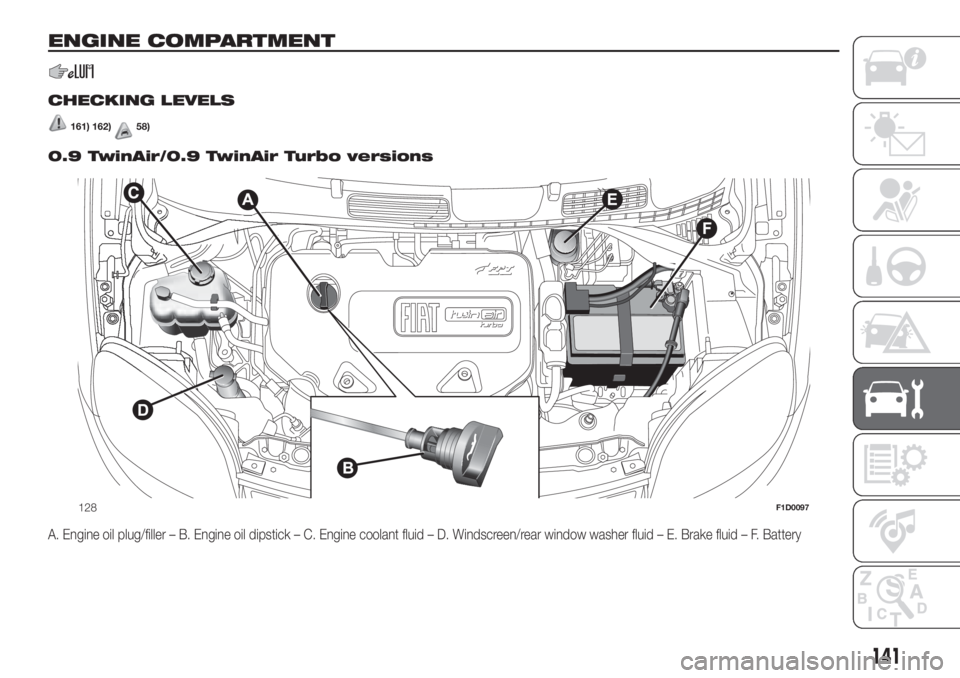
ENGINE COMPARTMENT
.
CHECKING LEVELS
161) 162)58)
0.9 TwinAir/0.9 TwinAir Turbo versions
A. Engine oil plug/filler – B. Engine oil dipstick – C. Engine coolant fluid – D. Windscreen/rear window washer fluid – E. Brake fluid – F. Battery
128F1D0097
141
Page 144 of 228

1.2 8V 69 HP versions
A. Engine oil plug/filler – B. Engine oil dipstick – C. Engine coolant fluid – D. Windscreen/rear window washer fluid – E. Brake fluid – F. Battery
129F1D0098
142
SERVICING AND CARE
Page 145 of 228
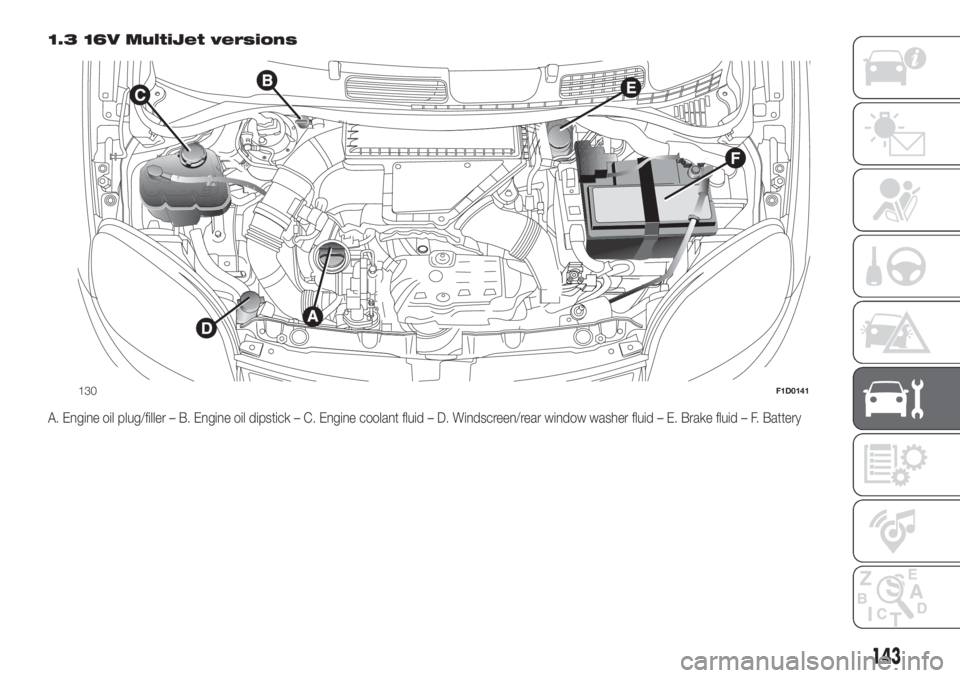
1.3 16V MultiJet versions
A. Engine oil plug/filler – B. Engine oil dipstick – C. Engine coolant fluid – D. Windscreen/rear window washer fluid – E. Brake fluid – F. Battery
130F1D0141
143
Page 146 of 228
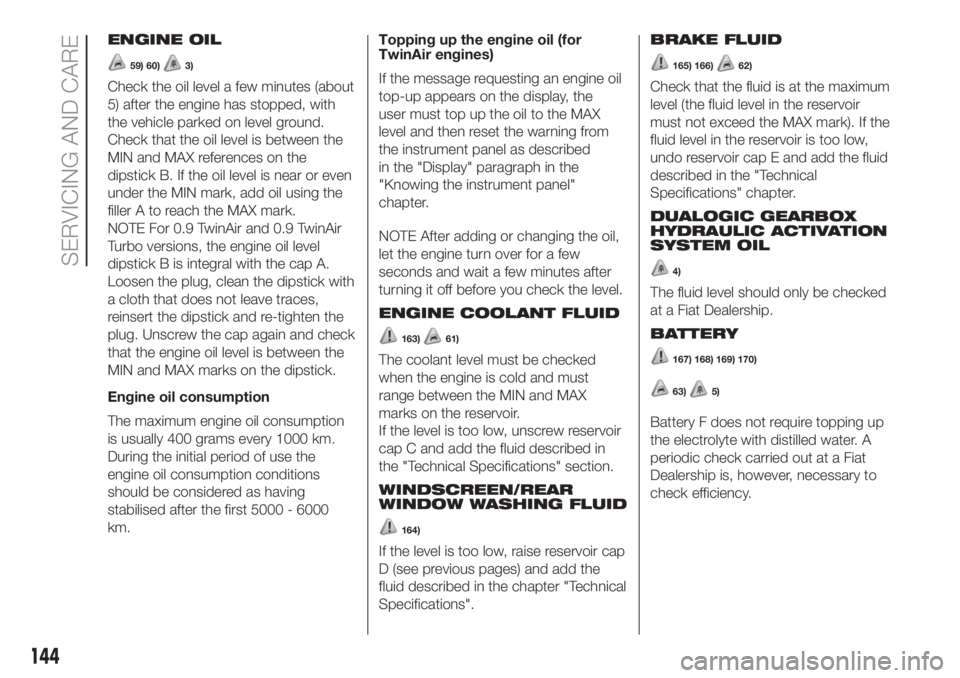
ENGINE OIL
59) 60)3)
Check the oil level a few minutes (about
5) after the engine has stopped, with
the vehicle parked on level ground.
Check that the oil level is between the
MIN and MAX references on the
dipstick B. If the oil level is near or even
under the MIN mark, add oil using the
filler A to reach the MAX mark.
NOTE For 0.9 TwinAir and 0.9 TwinAir
Turbo versions, the engine oil level
dipstick B is integral with the cap A.
Loosen the plug, clean the dipstick with
a cloth that does not leave traces,
reinsert the dipstick and re-tighten the
plug. Unscrew the cap again and check
that the engine oil level is between the
MIN and MAX marks on the dipstick.
Engine oil consumption
The maximum engine oil consumption
is usually 400 grams every 1000 km.
During the initial period of use the
engine oil consumption conditions
should be considered as having
stabilised after the first 5000 - 6000
km.Topping up the engine oil (for
TwinAir engines)
If the message requesting an engine oil
top-up appears on the display, the
user must top up the oil to the MAX
level and then reset the warning from
the instrument panel as described
in the "Display" paragraph in the
"Knowing the instrument panel"
chapter.
NOTE After adding or changing the oil,
let the engine turn over for a few
seconds and wait a few minutes after
turning it off before you check the level.
ENGINE COOLANT FLUID
163)61)
The coolant level must be checked
when the engine is cold and must
range between the MIN and MAX
marks on the reservoir.
If the level is too low, unscrew reservoir
cap C and add the fluid described in
the "Technical Specifications" section.
WINDSCREEN/REAR
WINDOW WASHING FLUID
164)
If the level is too low, raise reservoir cap
D (see previous pages) and add the
fluid described in the chapter "Technical
Specifications".BRAKE FLUID
165) 166)62)
Check that the fluid is at the maximum
level (the fluid level in the reservoir
must not exceed the MAX mark). If the
fluid level in the reservoir is too low,
undo reservoir cap E and add the fluid
described in the "Technical
Specifications" chapter.
DUALOGIC GEARBOX
HYDRAULIC ACTIVATION
SYSTEM OIL
4)
The fluid level should only be checked
at a Fiat Dealership.
BATTERY
167) 168) 169) 170)
63)5)
Battery F does not require topping up
the electrolyte with distilled water. A
periodic check carried out at a Fiat
Dealership is, however, necessary to
check efficiency.
144
SERVICING AND CARE
Page 147 of 228
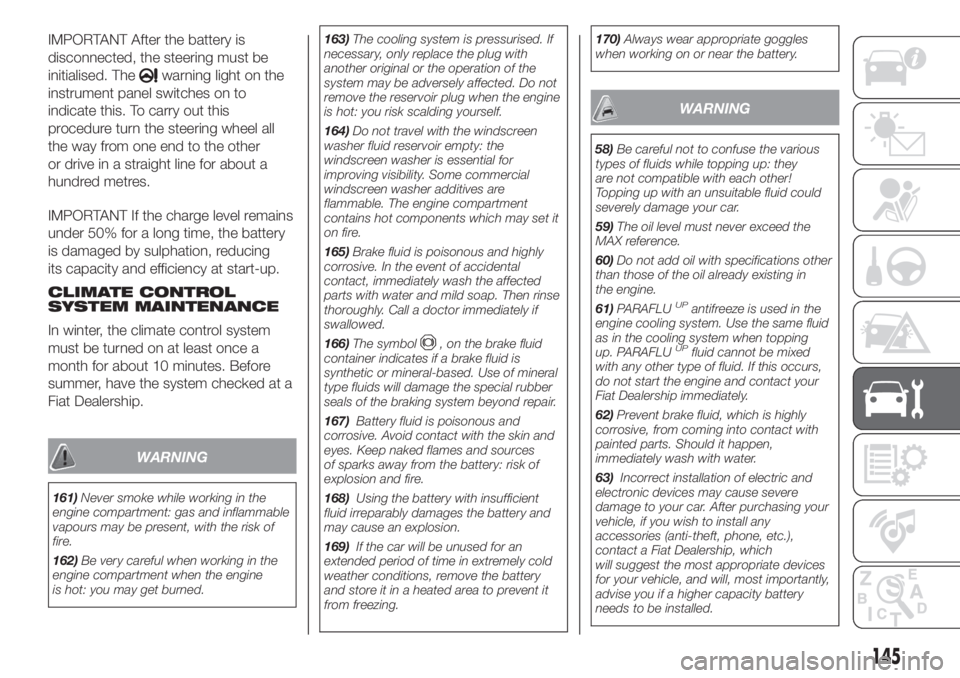
IMPORTANT After the battery is
disconnected, the steering must be
initialised. The
warning light on the
instrument panel switches on to
indicate this. To carry out this
procedure turn the steering wheel all
the way from one end to the other
or drive in a straight line for about a
hundred metres.
IMPORTANT If the charge level remains
under 50% for a long time, the battery
is damaged by sulphation, reducing
its capacity and efficiency at start-up.
CLIMATE CONTROL
SYSTEM MAINTENANCE
In winter, the climate control system
must be turned on at least once a
month for about 10 minutes. Before
summer, have the system checked at a
Fiat Dealership.
WARNING
161)Never smoke while working in the
engine compartment: gas and inflammable
vapours may be present, with the risk of
fire.
162)Be very careful when working in the
engine compartment when the engine
is hot: you may get burned.163)The cooling system is pressurised. If
necessary, only replace the plug with
another original or the operation of the
system may be adversely affected. Do not
remove the reservoir plug when the engine
is hot: you risk scalding yourself.
164)Do not travel with the windscreen
washer fluid reservoir empty: the
windscreen washer is essential for
improving visibility. Some commercial
windscreen washer additives are
flammable. The engine compartment
contains hot components which may set it
on fire.
165)Brake fluid is poisonous and highly
corrosive. In the event of accidental
contact, immediately wash the affected
parts with water and mild soap. Then rinse
thoroughly. Call a doctor immediately if
swallowed.
166)The symbol
, on the brake fluid
container indicates if a brake fluid is
synthetic or mineralbased. Use of mineral
type fluids will damage the special rubber
seals of the braking system beyond repair.
167)Battery fluid is poisonous and
corrosive. Avoid contact with the skin and
eyes. Keep naked flames and sources
of sparks away from the battery: risk of
explosion and fire.
168)Using the battery with insufficient
fluid irreparably damages the battery and
may cause an explosion.
169)If the car will be unused for an
extended period of time in extremely cold
weather conditions, remove the battery
and store it in a heated area to prevent it
from freezing.170)Always wear appropriate goggles
when working on or near the battery.
WARNING
58)Be careful not to confuse the various
types of fluids while topping up: they
are not compatible with each other!
Topping up with an unsuitable fluid could
severely damage your car.
59)The oil level must never exceed the
MAX reference.
60)Do not add oil with specifications other
than those of the oil already existing in
the engine.
61)PARAFLU
UPantifreeze is used in the
engine cooling system. Use the same fluid
as in the cooling system when topping
up. PARAFLU
UPfluid cannot be mixed
with any other type of fluid. If this occurs,
do not start the engine and contact your
Fiat Dealership immediately.
62)Prevent brake fluid, which is highly
corrosive, from coming into contact with
painted parts. Should it happen,
immediately wash with water.
63)Incorrect installation of electric and
electronic devices may cause severe
damage to your car. After purchasing your
vehicle, if you wish to install any
accessories (anti-theft, phone, etc.),
contact a Fiat Dealership, which
will suggest the most appropriate devices
for your vehicle, and will, most importantly,
advise you if a higher capacity battery
needs to be installed.
145
Page 148 of 228
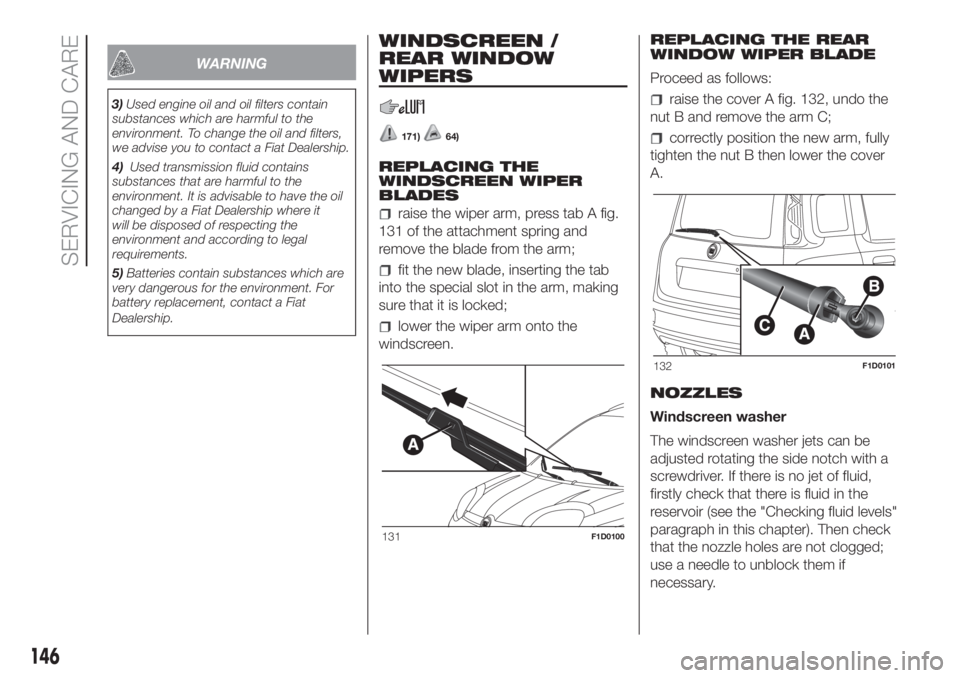
WARNING
3)Used engine oil and oil filters contain
substances which are harmful to the
environment. To change the oil and filters,
we advise you to contact a Fiat Dealership.
4)Used transmission fluid contains
substances that are harmful to the
environment. It is advisable to have the oil
changed by a Fiat Dealership where it
will be disposed of respecting the
environment and according to legal
requirements.
5)Batteries contain substances which are
very dangerous for the environment. For
battery replacement, contact a Fiat
Dealership.
WINDSCREEN /
REAR WINDOW
WIPERS
171)64)
REPLACING THE
WINDSCREEN WIPER
BLADES
raise the wiper arm, press tab A fig.
131 of the attachment spring and
remove the blade from the arm;
fit the new blade, inserting the tab
into the special slot in the arm, making
sure that it is locked;
lower the wiper arm onto the
windscreen.REPLACING THE REAR
WINDOW WIPER BLADE
Proceed as follows:
raise the cover A fig. 132, undo the
nut B and remove the arm C;
correctly position the new arm, fully
tighten the nut B then lower the cover
A.
NOZZLES
Windscreen washer
The windscreen washer jets can be
adjusted rotating the side notch with a
screwdriver. If there is no jet of fluid,
firstly check that there is fluid in the
reservoir (see the "Checking fluid levels"
paragraph in this chapter). Then check
that the nozzle holes are not clogged;
use a needle to unblock them if
necessary.
131F1D0100
132F1D0101
146
SERVICING AND CARE
Page 149 of 228
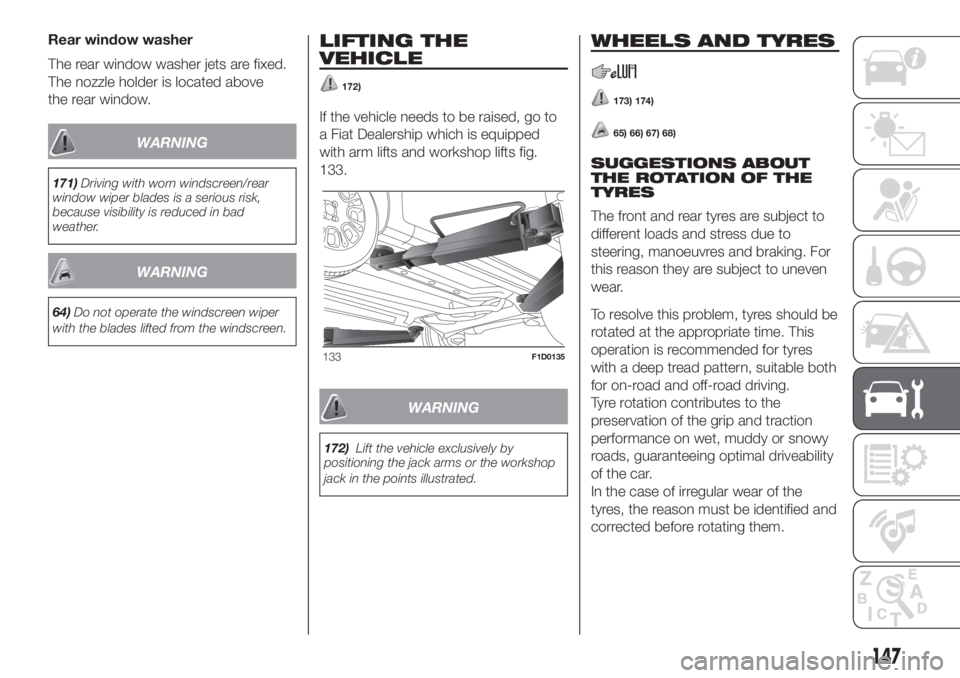
Rear window washer
The rear window washer jets are fixed.
The nozzle holder is located above
the rear window.
WARNING
171)Driving with worn windscreen/rear
window wiper blades is a serious risk,
because visibility is reduced in bad
weather.
WARNING
64)Do not operate the windscreen wiper
with the blades lifted from the windscreen.
LIFTING THE
VEHICLE
172)
If the vehicle needs to be raised, go to
a Fiat Dealership which is equipped
with arm lifts and workshop lifts fig.
133.
WARNING
172)Lift the vehicle exclusively by
positioning the jack arms or the workshop
jack in the points illustrated.
WHEELS AND TYRES
173) 174)
65) 66) 67) 68)
SUGGESTIONS ABOUT
THE ROTATION OF THE
TYRES
The front and rear tyres are subject to
different loads and stress due to
steering, manoeuvres and braking. For
this reason they are subject to uneven
wear.
To resolve this problem, tyres should be
rotated at the appropriate time. This
operation is recommended for tyres
with a deep tread pattern, suitable both
for on-road and off-road driving.
Tyre rotation contributes to the
preservation of the grip and traction
performance on wet, muddy or snowy
roads, guaranteeing optimal driveability
of the car.
In the case of irregular wear of the
tyres, the reason must be identified and
corrected before rotating them.
133F1D0135
147
Page 150 of 228
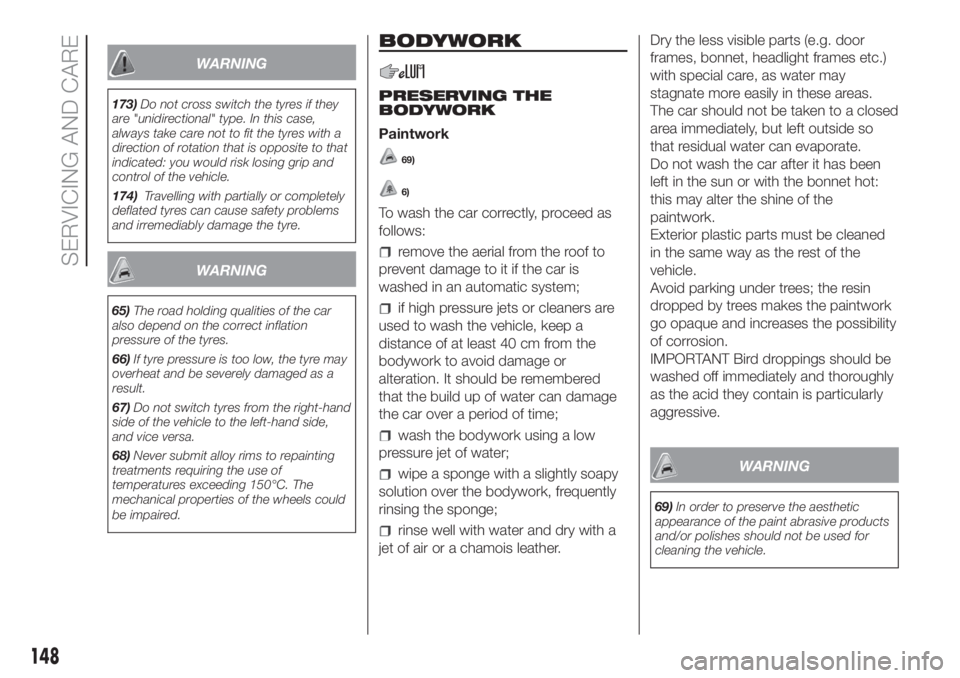
WARNING
173)Do not cross switch the tyres if they
are "unidirectional" type. In this case,
always take care not to fit the tyres with a
direction of rotation that is opposite to that
indicated: you would risk losing grip and
control of the vehicle.
174)Travelling with partially or completely
deflated tyres can cause safety problems
and irremediably damage the tyre.
WARNING
65)The road holding qualities of the car
also depend on the correct inflation
pressure of the tyres.
66)If tyre pressure is too low, the tyre may
overheat and be severely damaged as a
result.
67)Do not switch tyres from the righthand
side of the vehicle to the lefthand side,
and vice versa.
68)Never submit alloy rims to repainting
treatments requiring the use of
temperatures exceeding 150°C. The
mechanical properties of the wheels could
be impaired.
BODYWORK
PRESERVING THE
BODYWORK
Paintwork
69)
6)
To wash the car correctly, proceed as
follows:
remove the aerial from the roof to
prevent damage to it if the car is
washed in an automatic system;
if high pressure jets or cleaners are
used to wash the vehicle, keep a
distance of at least 40 cm from the
bodywork to avoid damage or
alteration. It should be remembered
that the build up of water can damage
the car over a period of time;
wash the bodywork using a low
pressure jet of water;
wipe a sponge with a slightly soapy
solution over the bodywork, frequently
rinsing the sponge;
rinse well with water and dry with a
jet of air or a chamois leather.Dry the less visible parts (e.g. door
frames, bonnet, headlight frames etc.)
with special care, as water may
stagnate more easily in these areas.
The car should not be taken to a closed
area immediately, but left outside so
that residual water can evaporate.
Do not wash the car after it has been
left in the sun or with the bonnet hot:
this may alter the shine of the
paintwork.
Exterior plastic parts must be cleaned
in the same way as the rest of the
vehicle.
Avoid parking under trees; the resin
dropped by trees makes the paintwork
go opaque and increases the possibility
of corrosion.
IMPORTANT Bird droppings should be
washed off immediately and thoroughly
as the acid they contain is particularly
aggressive.
WARNING
69)In order to preserve the aesthetic
appearance of the paint abrasive products
and/or polishes should not be used for
cleaning the vehicle.
148
SERVICING AND CARE